Interaction between Pharmaceutical Drugs and Polymer-Coated Fe3O4 Magnetic Nanoparticles with Langmuir Monolayers as Cellular Membrane Models
Abstract
1. Introduction
2. Materials and Methods
2.1. Materials
2.2. Methods
2.2.1. Surface Pressure—Area Isotherms
2.2.2. Insertion Experiments
3. Results
3.1. Langmuir Monolayers
3.1.1. HTFPZ+:DSPA and DCFN−:DSPA Composite Langmuir Films
3.1.2. Surface Pressure Isotherms of MNPs:DSPA Containing HTFPZ+ in the Subphase
3.1.3. Surface Pressure Isotherms of MNPs:DSPA Containing DCFN− in the Subphase
3.2. Insertion Experiments on DSPA Pre-Formed Monolayer
3.2.1. Insertion of HTFPZ+ or DCFN− with Preformed DSPA Monolayer
3.2.2. Insertion of MNPs:HTFPZ+ or MNPs:DCFN− with Preformed DSPA Monolayer
4. Discussion
Supplementary Materials
Author Contributions
Funding
Institutional Review Board Statement
Informed Consent Statement
Data Availability Statement
Acknowledgments
Conflicts of Interest
References
- Nobre, T.M.; Pavinatto, F.J.; Caseli, L.; Barros-Timmons, A.; Dynarowicz-Łątka, P.; Oliveira, O.N., Jr. Interactions of bioactive molecules & nanomaterials with Langmuir monolayers as cell membrane models. Thin Solid Films 2015, 593, 158–188. [Google Scholar]
- Hąc-Wydro, K.; Dynarowicz-Łątka, P.; Żuk, R. Langmuir monolayer study towards combined antileishmanian therapy involving amphotericin B and Edelfosine. J. Phys. Chem. B 2009, 113, 14239–14246. [Google Scholar] [CrossRef] [PubMed]
- Gagoś, M.; Arczewska, M. Spectroscopic studies of molecular organization of antibiotic amphotericin B in monolayers and dipalmitoylphosphatidylcholine lipid multibilayers. Biochim. Biophys. Acta Biomembr 2010, 1798, 2124–2130. [Google Scholar] [CrossRef] [PubMed]
- Giuffrida, M.C.; Dosio, F.; Castelli, F.; Sarpietro, M.G. Lipophilic prodrug of paclitaxel: Interaction with a dimyristoylphosphatidylcholine monolayer. Int. J. Pharm. 2014, 475, 624–631. [Google Scholar] [CrossRef]
- Hąc-Wydro, K.; Dynarowicz-Łątka, P. Searching for the role of membrane sphingolipids in selectivity of antitumor ether lipid—Edelfosine. Colloids Surf. B Biointerfaces 2010, 81, 492–497. [Google Scholar] [CrossRef]
- Souza, S.M.B.; Oliveira, O.N., Jr.; Scarpa, M.V.; Oliveira, A.G. Study of the diclofenac/phospholipid interactions with liposomes and monolayers. Colloids Surf. B Biointerfaces 2004, 36, 13–17. [Google Scholar] [CrossRef] [PubMed]
- Lygre, H.; Moe, G.; Holmsen, H. Interaction of ibuprofen with eukaryotic membrane lipids. Acta Odontol. Scand. 2003, 61, 303–309. [Google Scholar] [CrossRef]
- Jabłonowska, E.; Bilewicz, R. Interactions of ibuprofen with Langmuir monolayers of membrane lipids. Thin Solid Films 2007, 515, 3962–3966. [Google Scholar] [CrossRef]
- Micieli, D.; Giuffrida, M.C.; Pignatello, R.; Castelli, F.; Sarpietro, M.G. Interaction of naproxen amphiphilic derivatives with biomembrane models evaluated by differential scanning calorimetry and Langmuir–Blodgett studies. J. Colloid Interface Sci. 2011, 360, 359–369. [Google Scholar] [CrossRef]
- Choi, S.Y.; Oh, S.G.; Lee, J.S. Effects of lidocaine on the expansion of lipid monolayer at air/water interface in relation to the local anesthesia. Colloids Surf. B Biointerfaces 2000, 17, 255–264. [Google Scholar] [CrossRef]
- Hidalgo, A.A.; Caetano, W.; Tabak, M.; Oliveira, O.N. Interaction of two phenothiazine derivatives with phospholipid monolayers. Biophys. Chem. 2004, 109, 85–104. [Google Scholar] [CrossRef] [PubMed]
- Colqui Quiroga, M.V.; Monzón, L.M.A.; Yudi, L.M. Interaction of triflupromazine with distearoylphosphatidylglycerol films studied by surface pressure isotherms and cyclic voltammetry at a 1,2-dichloroethane/water interface. Electrochim. Acta 2010, 55, 5840–5846. [Google Scholar] [CrossRef]
- Colqui Quiroga, M.V.; Monzón, L.M.A.; Yudi, L.M. Voltammetric study and surface pressure isotherms describing Flunitrazepam incorporation into a distearoylphosphatidic acid film adsorbed at air/water and water/1,2-dichloroethane interfaces. Electrochim. Acta 2011, 56, 7022–7028. [Google Scholar] [CrossRef]
- Gzyl-Malcher, B.; Handzlik, J.; Klekowska, E. Temperature dependence of the interaction of prazosin with lipid Langmuir monolayers. Colloids Surf. B Biointerfaces 2013, 112, 171–176. [Google Scholar] [CrossRef] [PubMed]
- Brockman, H.; Graff, G.; Spellman, J.; Yanni, J. A comparison of the effects of olopatadine and ketotifen on model membranes. Acta Ophthalmol. Scand. 2000, 78, 10–15. [Google Scholar] [CrossRef]
- Rahdar, A.; Hajinezhad, M.R.; Sargazi, S.; Barani, M.; Karimi, P.; Velasco, B.; Taboada, P.; Pandey, S.; Bameri, Z.; Zarei, S. Pluronic F127/carfilzomib-based nanomicelles as promising nanocarriers: Synthesis, characterization, biological, and in silico evaluations. J. Mol. Liq. 2022, 346, 118271. [Google Scholar] [CrossRef]
- Mohammadzadeh, V.; Rahiman, N.; Hosseinikhah, S.M.; Barani, M.; Rahdar, A.; Jaafari, M.R.; Sargazi, S.; Zirak, M.R.; Pandey, S.; Bhattacharjee, R.; et al. Gupta, Novel EPR-enhanced strategies for targeted drug delivery in pancreatic cancer: An update. J. Drug Deliv. Sci. Technol. 2022, 73, 103459. [Google Scholar] [CrossRef]
- MBarani, M.; Sargazi, S.; Hajinezhad, M.R.; Rahdar, A.; Sabir, F.; Pardakhty, A.; Zargari, F.; Anwer, M.K.; Aboudzadeh, M.A. Aboudzadeh, Preparation of pH-Responsive Vesicular Deferasirox: Evidence from In Silico, In Vitro, and In Vivo Evaluations. ACS Omega 2021, 6, 24218–24232. [Google Scholar] [CrossRef]
- Massami Uehara, T.; Spolon Marangoni, V.; Pasquale, N.; Barbeitas Miranda, P.; Lee, K.; Zucolotto, V. A Detailed Investigation on the Interactions between Magnetic Nanoparticles and Cell Membrane Models. ACS Appl. Mater. Interfaces 2013, 5, 13063–13068. [Google Scholar] [CrossRef]
- Ábrahám, N.; Csapó, E.; Bohus, G.; Dékány, I. Interaction of biofunctionalized gold nanoparticles with model phospholipid membranes. Colloid Polym. Sci. 2014, 292, 2715–2725. [Google Scholar] [CrossRef]
- Moya Betancourt, S.N.; Cámara, C.I.; Juarez, A.V.; Pozo López, G.; Riva, J.S. Effect of magnetic nanoparticle coating on their electrochemical behaviour at a polarized liquid/liquid interface. J. Electroanal. Chem. 2022, 911, 116253. [Google Scholar] [CrossRef]
- Moya Betancourt, S.N.; Uranga, J.G.; Cámara, C.I.; Juarez, A.V.; Pozo López, G.; Riva, J.S. Effect of bare and polymeric-modified magnetic nanoparticles on the drug ion transfer across liquid/liquid interfaces. J. Electroanal. Chem. 2022, 919, 116502. [Google Scholar] [CrossRef]
- Rinaudo, M. Chitin and chitosan: Properties and applications. Prog. Polym. Sci. 2006, 31, 603–632. [Google Scholar] [CrossRef]
- Rojewska, M.; Tim, B.; Prochaska, K. Interactions between silica particles and model phospholipid monolayers. J. Molecular Liquids 2022, 345, 116999. [Google Scholar] [CrossRef]
- Gaines, G.L. Insoluble Monolayers at Liquid-Gas Interfaces, 1st ed.; Interscience Publishers: New York, NY, USA, 1966. [Google Scholar]
- Vollhardt, D.; Fainerman, V.B. Progress in characterization of Langmuir monolayers by consideration of compressibility. Adv. Colloid Interface Sci. 2006, 127, 83–97. [Google Scholar] [CrossRef] [PubMed]
- Cámara, C.I.; Yudi, L.M. Potential-mediated interaction between dextran sulfate and negatively charged phospholipids films at air/water and liquid/liquid interfaces. Electrochimica Acta 2013, 113, 644–652. [Google Scholar] [CrossRef]
- Geraldo, V.P.; Pavinatto, F.J.; Nobre, T.M.; Caseli, L.; Oliveira, O.N., Jr. Langmuir films containing ibuprofen and phospholipids. Chem. Phys. Lett. 2013, 559, 99–106. [Google Scholar] [CrossRef]
- Villanueva, M.E.; Lanterna, A.E.; Vico, R.V. Hydrophobic silver nanoparticles interacting with phospholipids and stratum corneum mimic membranes in Langmuir monolayers. J. Colloid Interface Sci. 2019, 543, 247–255. [Google Scholar] [CrossRef]
- Popescu, R.C.; Andronescu, E.; Grumezescu, A.M. In vivo evaluation of Fe3O4 nanoparticles. Rom. J. Morphol. Embryol. 2014, 55, 1013–1018. [Google Scholar]
- Ding, Y.; Shen, S.Z.; Sun, H.; Sun, K.; Liu, F.; Qi, Y.; Yan, J. Design and construction of polymerized-chitosan coated Fe3O4 magnetic nanoparticles and its application for hydrophobic drug delivery. Mater. Sci. Eng. C 2015, 48, 487–498. [Google Scholar] [CrossRef]
- Uribe Madrid, S.I.; Pal, U.; Kang, Y.S.; Kim, J.; Kwon, H.; Kim, J. Fabrication of Fe3O4@mSiO2 core-shell composite nanoparticles for drug delivery applications. Nanoscale Res. Lett. 2015, 10, 217. [Google Scholar] [CrossRef] [PubMed]
- Jia, Y.; Yuan, M.; Yuan, H.; Huang, X.; Sui, X.; Cui, X.; Guo, Q. Co-encapsulation of magnetic Fe3O4 nanoparticles and doxorubicin into biodegradable PLGA nanocarriers for intratumoral drug delivery. Int. J. Nanomedicine 2012, 7, 1697. [Google Scholar] [PubMed]
- Lin, J.; Zhang, H.; Chen, Z.; Zheng, Y. Penetration of lipid membranes by gold nanoparticles: Insights into cellular uptake, cytotoxicity, and their relationship. ACS Nano 2010, 4, 5421–5429. [Google Scholar] [CrossRef] [PubMed]
- Feng, S.S.; Gong, K.; Chew, J. Molecular interactions between a lipid and an antineoplastic drug paclitaxel (taxol) within the lipid monolayer at the air/water interface. Langmuir 2002, 18, 4061–4070. [Google Scholar] [CrossRef]
- Xie, B.; Hao, C.; Sun, R. Effect of fluoxetine at different concentrations on the adsorption behaviour of Langmuir monolayers. Biochim. Biophys. Acta Biomembr. 2020, 1862, 183418. [Google Scholar] [CrossRef]
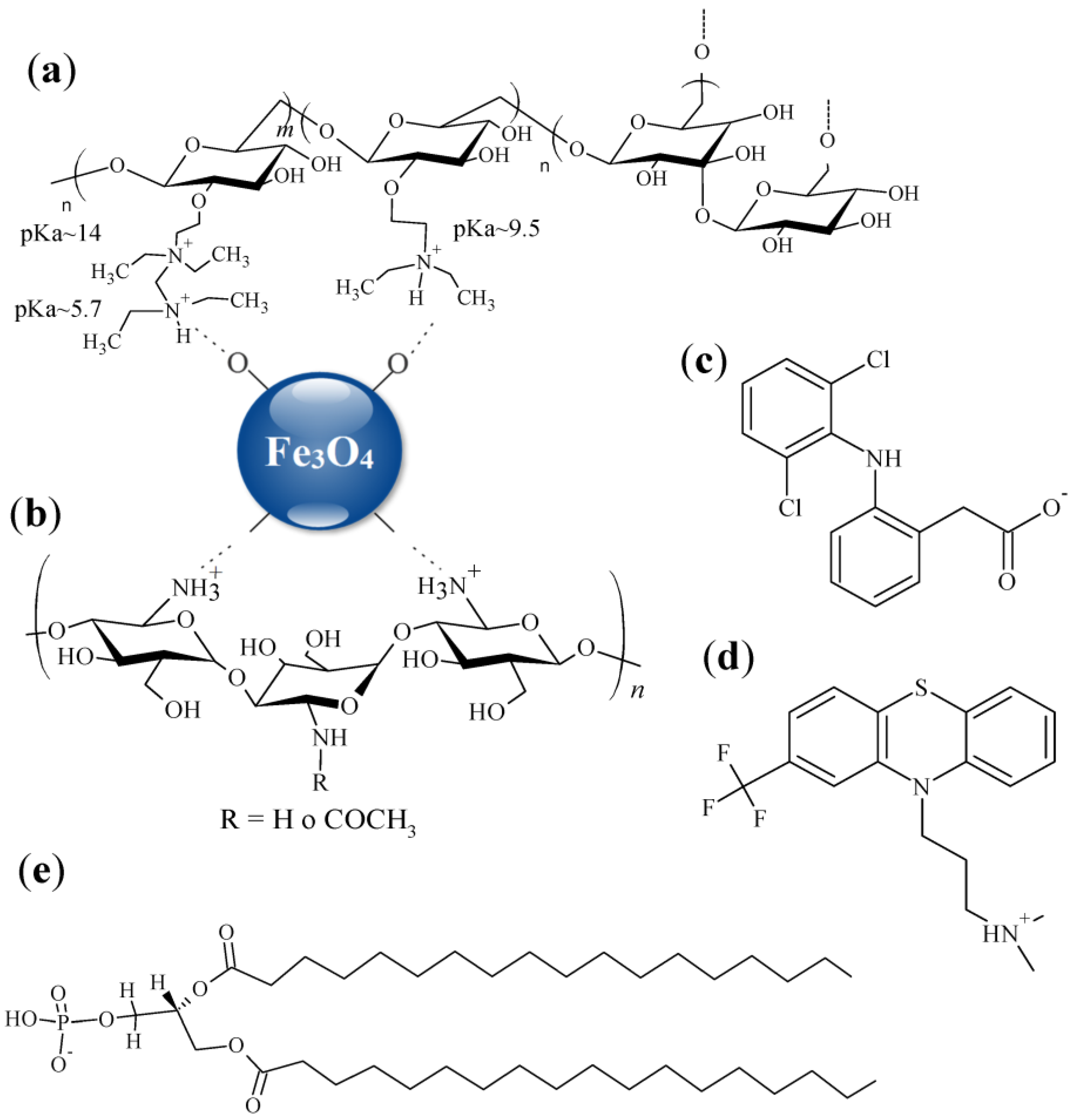
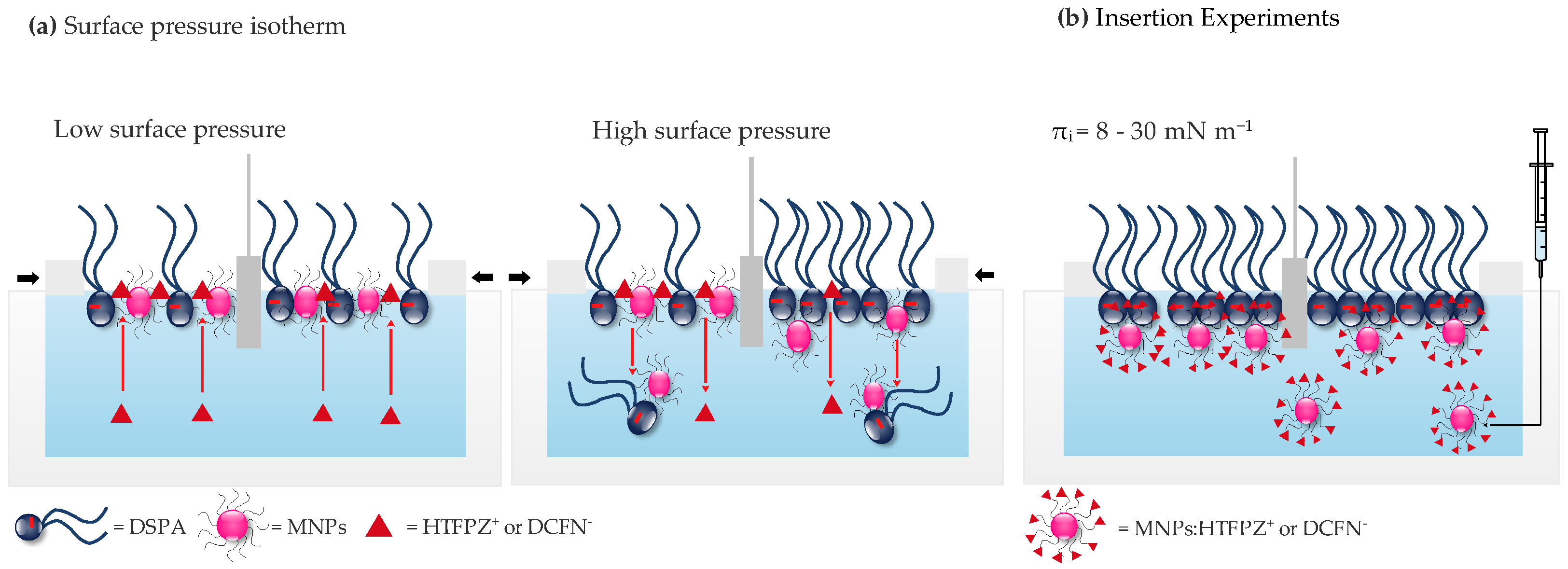
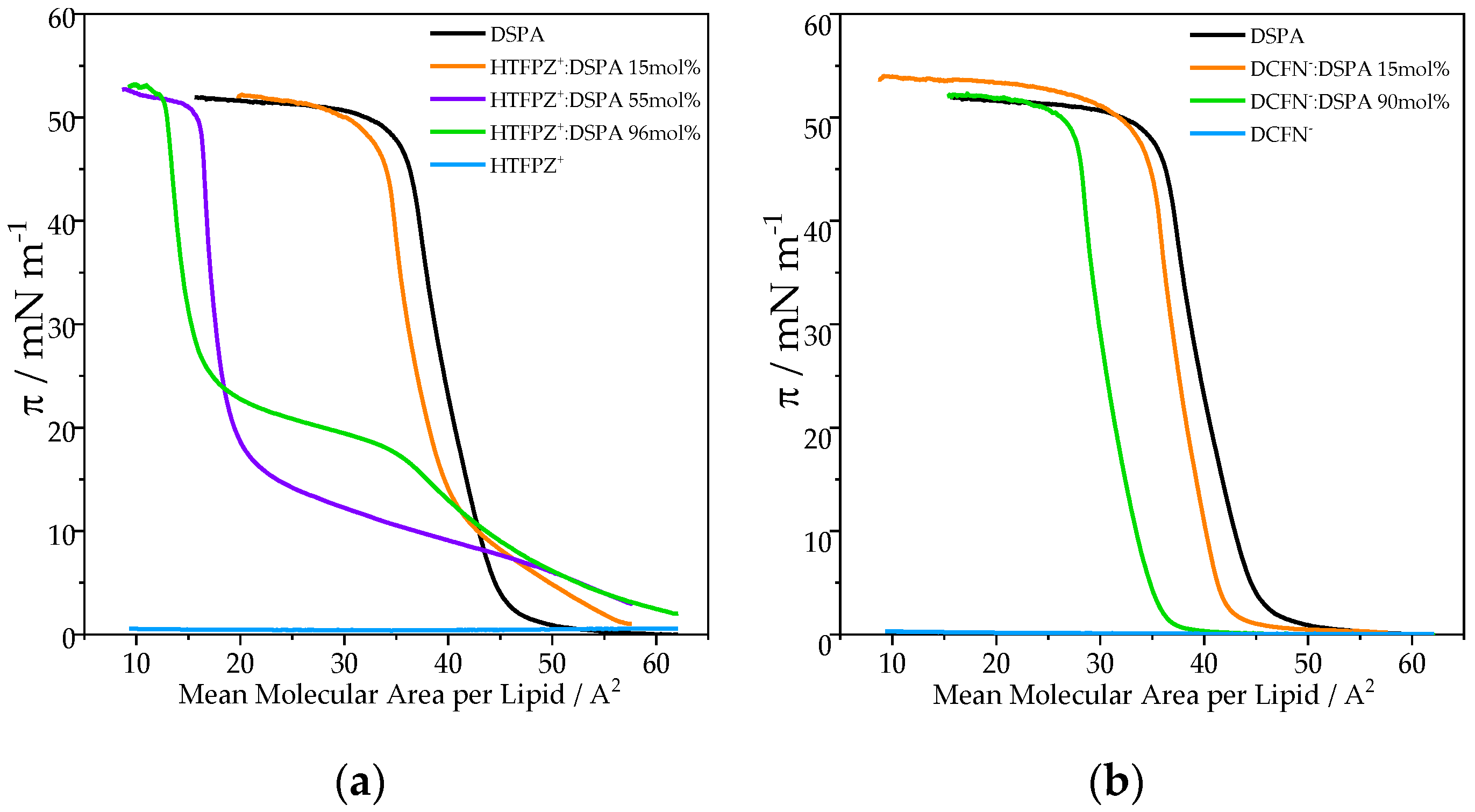

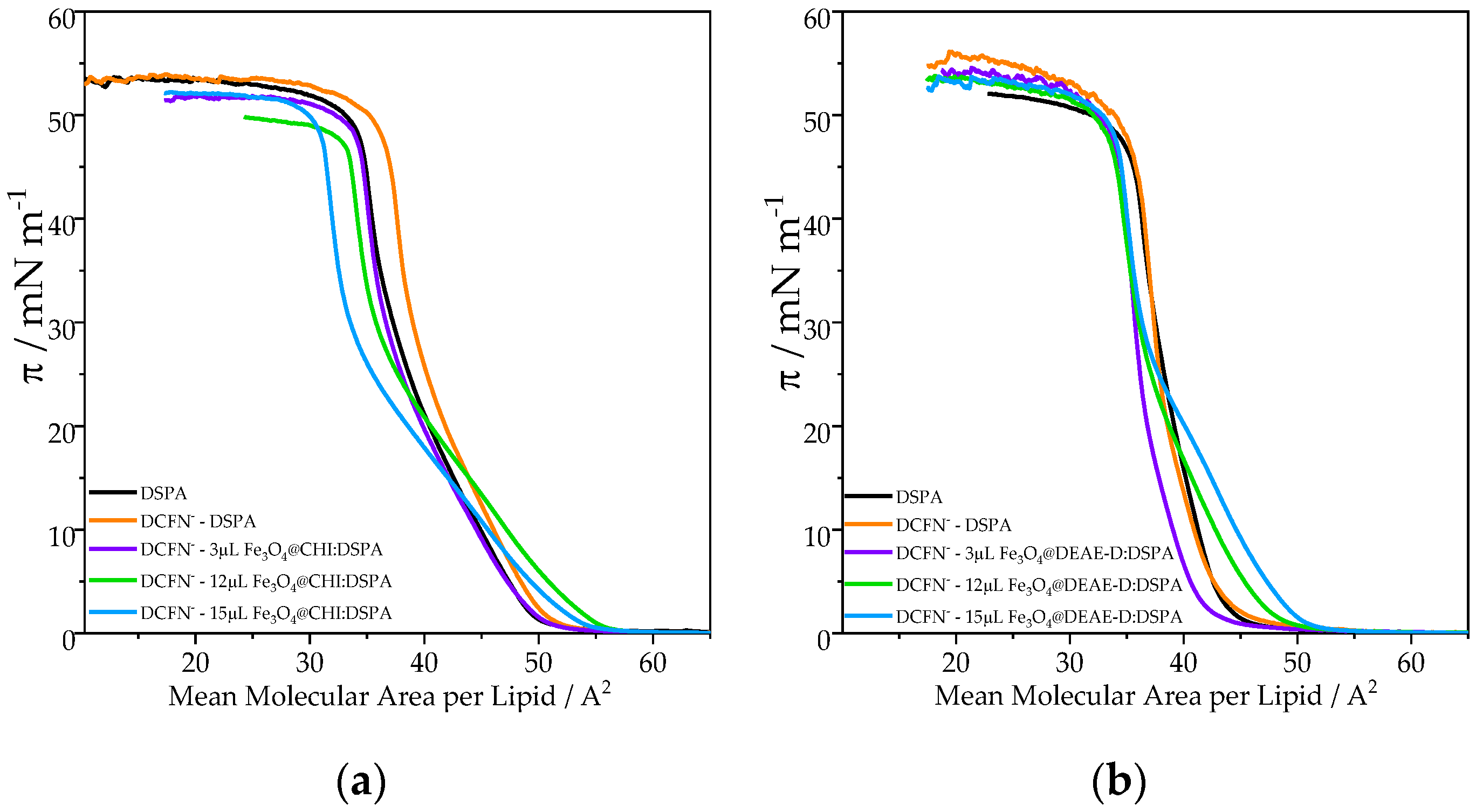


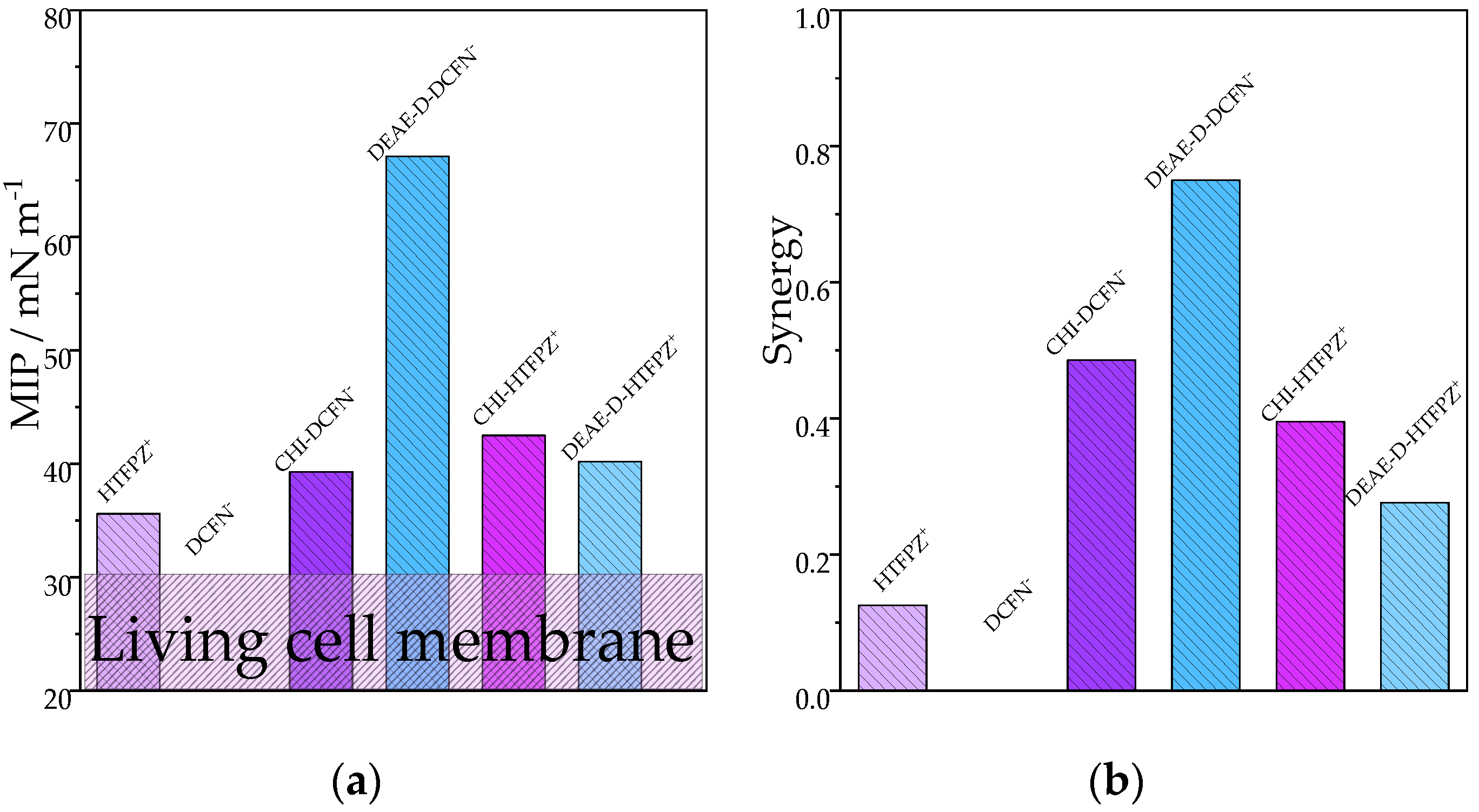
| µL MNPs Dispersion:DSPA | Cs−1/mN m−1 | ||
|---|---|---|---|
| Subphase with: LiCl | Subphase with: HTPFZ+ | Subphase with: DCFN− | |
| 0 µL MNPs:DSPA | 275.69 | 100.00 | 261.09 |
| 3 µL Fe3O4@CHI:DSPA | - | 77.38 | 161.51 |
| 12 µL Fe3O4@CHI:DSPA | - | 65.91 | 130.24 |
| 15 µL Fe3O4@CHI:DSPA | - | 57.88 | 115.53 |
| 3 µL Fe3O4@DEAE-D:DSPA | - | 77.38 | 442.99 |
| 12 µL Fe3O4@DEAE-D:DSPA | - | 65.91 | 208.21 |
| 15 µL Fe3O4@DEAE-D:DSPA | - | 57.88 | 184.94 |
Disclaimer/Publisher’s Note: The statements, opinions and data contained in all publications are solely those of the individual author(s) and contributor(s) and not of MDPI and/or the editor(s). MDPI and/or the editor(s) disclaim responsibility for any injury to people or property resulting from any ideas, methods, instructions or products referred to in the content. |
© 2023 by the authors. Licensee MDPI, Basel, Switzerland. This article is an open access article distributed under the terms and conditions of the Creative Commons Attribution (CC BY) license (https://creativecommons.org/licenses/by/4.0/).
Share and Cite
Moya Betancourt, S.N.; Cámara, C.I.; Riva, J.S. Interaction between Pharmaceutical Drugs and Polymer-Coated Fe3O4 Magnetic Nanoparticles with Langmuir Monolayers as Cellular Membrane Models. Pharmaceutics 2023, 15, 311. https://doi.org/10.3390/pharmaceutics15020311
Moya Betancourt SN, Cámara CI, Riva JS. Interaction between Pharmaceutical Drugs and Polymer-Coated Fe3O4 Magnetic Nanoparticles with Langmuir Monolayers as Cellular Membrane Models. Pharmaceutics. 2023; 15(2):311. https://doi.org/10.3390/pharmaceutics15020311
Chicago/Turabian StyleMoya Betancourt, Sara Natalia, Candelaria Inés Cámara, and Julieta Soledad Riva. 2023. "Interaction between Pharmaceutical Drugs and Polymer-Coated Fe3O4 Magnetic Nanoparticles with Langmuir Monolayers as Cellular Membrane Models" Pharmaceutics 15, no. 2: 311. https://doi.org/10.3390/pharmaceutics15020311
APA StyleMoya Betancourt, S. N., Cámara, C. I., & Riva, J. S. (2023). Interaction between Pharmaceutical Drugs and Polymer-Coated Fe3O4 Magnetic Nanoparticles with Langmuir Monolayers as Cellular Membrane Models. Pharmaceutics, 15(2), 311. https://doi.org/10.3390/pharmaceutics15020311









